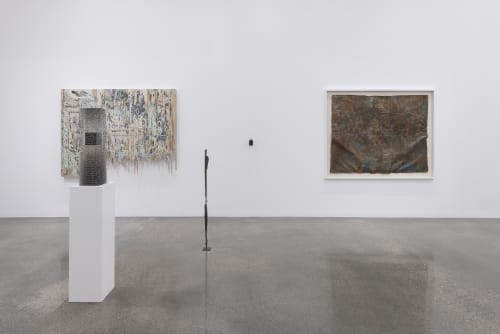We are pleased to present By the Movement of All Things, a group exhibition curated by Hamzeh Alfarahneh, featuring works by Igshaan Adams (b.1982, South African), Hamra Abbas (b. 1976, Pakistani), Diana Al-Hadid (b. 1981, Syrian-American), James Webb (b. 1975, South African), Bronwyn Katz (b. 1993, South African), Timo Nasseri (b. 1972, German-Iranian) and Moshekwa Langa (b. 1975, South African). The exhibition opens on 16 November 2025 and will be on view until 6 January, 2026.
By the Movement of All Things invites the viewer to act upon an inherent curiosity, using art as a vehicle for encounter and learning. The title, borrowed from Aimé Césaire’s Notebook of a Return to My Native Land, sets a tone of active participation, calling the audience to engage with the works not merely by projecting meaning but by reflecting their own lived experiences.
The exhibition continues Hamzeh Alfarahneh’s ongoing investigation into Global Majority abstract practices, following last year’s Ex Situ: A Snapshot of Contemporary South African Abstraction, which traced the trajectories of abstraction in South Africa from the postwar period to the present. With By the Movement of All Things, Alfarahneh’s attention shifts toward affinities and resonances between South African and Middle Eastern non-figurative practices, foregrounding lines of contact that complicate established regional and disciplinary narratives.
Here, for the first time in this curatorial sequence, the exhibition is organised through a framework that Alfarahneh terms as structures of knowledge—a mode of thinking that interrogates what kinds of knowledge exist outside the dominant canon and what role curators and institutions play in safeguarding, proposing and presenting non-institutional know-how, thematics and ancestral wisdoms. Rather than offering neat oppositions, the framework asks how exhibition-making can surface practices of knowing that operate through gesture, lineage and embodied memory.
Within this framework, knowledge is imagined as a series of planes or conceptual layers that can be linked and intersected to form provisional structures of understanding. While this model frequently lends itself to large-scale institutional projects, it proves generative here in a more intimate gallery context by concentrating on gesture and motion as a singular plane of knowledge. Through the practices of the participating artists, the exhibition considers how gesture, movement and vibration operate as conduits of knowledge-keeping, and how abstraction can hold and transmit these ephemeral forms of knowing.
For By the Movement of All Things, abstraction is not posed simply as the opposite of representation but as a site in which traces, gestures and histories may be simultaneously revealed and occluded. The works gathered here explore how the body inhabits time and space through movement: they are not performances in themselves but the remnants of performance—residues of ephemeral acts that register presence, index motion and memorialize passage. If gesture is fleeting and movement is the accumulation of gestures, then these works function as the collateral traces of movement, preserving a record of where and how bodies and materials have met.
Igshaan Adams combines sculpture, installation, and textile to create intricate works that trace memory, spirituality, and transformation. Everyday materials are woven into abstract forms that register both personal and collective narratives, inviting the viewer to consider the intersections of history, place, and identity. Similarly, Diana Al-Hadid’s sculptures merge architecture, art history, and myth, balancing solidity and fragility while navigating the tension between illusion and structure. James Webb extends this inquiry into space and perception through sound, installation, and intervention, producing immersive experiences that layer cultural, spiritual, and sensory dimensions.
Continuing this focus on materiality and form, Bronwyn Katz and Timo Nasseri each approach sculpture through distinct yet complementary practices. Katz works with copper-coated steel, twine, and wire to investigate natural textures and constructed frameworks, balancing delicacy with strength, while Nasseri’s minimalist steel works emphasize geometry, proportion, and the interplay of structure and void. Moshekwa Langa, spanning drawing, painting, sculpture, and installation, maps memory, movement, and personal narratives into layered, tactile compositions, employing materials such as charcoal, soil, and fabric to register both bodily presence and temporal flow.
Hamra Abbas works with marble to explore form, texture, and the play of light and shadow, blending classical craftsmanship with contemporary abstraction. Her sculptures reflect on the passage of time and the transformations of landscapes and environments, connecting material presence with broader natural and temporal forces.
Together, the selection highlights the continuity of a gestural language across media, underscoring how abstraction can serve as a repository for communal memory, technique and spiritual knowing. By the Movement of All Things thus positions movement not merely as subject but as method: an active condition through which histories are kept, transmitted and renewed.
